The Latest from Boing Boing |  |
- List of economists involved in violent sex crimes, for Ben Stein
- Creep recorded women with hidden surveillance camera inside Starbucks restroom
- New security vulnerability forces Sony to take part of PSN offline yet again
- Guantanamo detainee from Afghanistan commits suicide
- Man chooses "elective amputation" for bionic hand, after motorcycle accident
- Got a question for shuttle Endeavour astronauts? Live PBS webcast Q&A, Thu 6am ET
- New York Times discovers yarn-bombers
- Tips for dungeon master daddies (and mommies)
- Virgin Galactic's "feathered flight" as a David Ope animated GIF
- Intro to L.A. Noire fiction anthology: a Boing Boing exclusive
- bOING bOING: free collection from the print zine, 1989-1997
- You've been a bad, bad sysadmin
- Locke & Key: creepy and excellent graphic novel
- U.S. Secret Service pulls a herp derp on Twitter
- Standing Desk Jockey: Kai Vermehr of eBoy
- Sunglasses that make you look like you've had your eyes blacked out
- Billions of planets, alone in space?
- Grizzly bear beanbag chair
- Super senses exist, we're just too distracted to notice them
- Portal prank: covering up crosswalk button sign
- Most expensive art photo ever
- An explanation for Roswell that's crazier than aliens
- Free download of horror film The Tunnel
- HOWTO take pictures at a club/bar/venue
- HIV and twins
- Middleweight public intellectuals defend Dominique Strauss-Kahn
- All 6500+ pages of Elfquest comics online
- 'Taint hard to find a physical link to male fertility
- Update on "Spanish Revolution" protests: riot police surrounding protesters in Madrid
- David Dobbs on the importance of open-source science
| List of economists involved in violent sex crimes, for Ben Stein Posted: 18 May 2011 09:37 PM PDT Some further thoughts on Ben Stein's defense of IMF Chief Dominique Strauss-Kahn in the Spectator (recap: Stein claims that Strauss-Kahn is probably innocent for a lot of pretty silly reasons). Randall Munroe of XKCD takes up one of Stein's claims: "Can anyone tell me any economists who have been convicted of violent sex crimes?" On a whim, I just did a little research, and couldn't believe what I found. Guess who holds an economics degree?One of Randall's readers provides a list of other economists who've been convicted of sex crimes. |
| Creep recorded women with hidden surveillance camera inside Starbucks restroom Posted: 18 May 2011 07:37 PM PDT  A 25-year-old man hid a video camera disguised as a plastic coat hook inside the women's restroom of a Starbucks in Glendora, CA, and secretly recorded more than 40 women and children using the toilet over two days. The man "downloaded the device about every hour to his laptop computer while sitting in his car," according to police. (LA Times) |
| New security vulnerability forces Sony to take part of PSN offline yet again Posted: 18 May 2011 08:19 PM PDT  Sony president Howard Stringer, taking an unexpected phone call, glances at consumer products chief Kazuo Hirai earlier today. PHOTO: UNIN TENDO/REUTERS Yes, again. Sony had to take part of its Sony PlayStation Network offline briefly today after it discovered a security vulnerability that allowed hackers to take over users' accounts. (ComputerWorld) |
| Guantanamo detainee from Afghanistan commits suicide Posted: 18 May 2011 06:24 PM PDT Another Guantanamo detainee died of an apparent suicide today. Here's the Department of Defense statement. |
| Man chooses "elective amputation" for bionic hand, after motorcycle accident Posted: 18 May 2011 06:29 PM PDT  A 26-year-old man in Austria who lost the use of his right hand in a motorcycle accident ten years ago has decided to undergo "elective amputation," after which he will be fitted with a bionic hand controlled by nerve signals from his own arm. German prosthetics company Otto Bock makes the bionic hands; BBC News reports the prosthetics can "pinch and grasp in response to signals from the brain that are picked up by two sensors placed over the skin above nerves in the forearm." This will be the second such surgery performed by Professor Oskar Aszmann, of Vienna. A 24-year-old Austrian man named Patrick was the first patient in the world to choose to have his hand amputated, again by Professor Aszmann, and a bionic replacement fitted. He lost the use of his left hand after being electrocuted at work.More here, and there's video of the bionic hand in use by Patrick, here. (Thanks, Marguerite // update: also found on Make today, via Phil Torrone) |
| Got a question for shuttle Endeavour astronauts? Live PBS webcast Q&A, Thu 6am ET Posted: 18 May 2011 06:06 PM PDT [Video Link] PBS NewsHour, Google, and YouTube are teaming up to produce a live webcast with the Space Shuttle Endeavour and International Space Station astronauts, starting between 6 and 6:30 a.m. ET on Thursday, May 19. Space journalist Miles O'Brien will host. The live webcast will be streamed at PBS and on YouTube. Led by Endeavour commander Mark Kelly, the astronauts will answer questions from the internet in a live Q&A session hosted by Miles, as the crew orbits the earth at 17,500 mph. They're still accepting questions! |
| New York Times discovers yarn-bombers Posted: 18 May 2011 05:43 PM PDT [S]he knitted what looked like a leg warmer for a stop sign down the street; from there she slowly infiltrated Houston with her stitchery. Within a few years, she had tagged dozens of lampposts and stop signs and assembled a crew of fellow yarn bombers she called Knitta Please."&mdsah;The New York Times on Magda Sayeg, a 37-year-old Texan considered "the mother of yarn bombing." |
| Tips for dungeon master daddies (and mommies) Posted: 18 May 2011 05:36 PM PDT  If you are not both a geek and a parent of geeks, then the following post will be of little interest. press the "j" key and move on. Otherwise, there's some good information for parents who like to play rpg with their kids. Tom Fassbender says: So I'm really digging the new Gweek podcast, and particularly I enjoyed your short review/recap of rpgKids and Joel's Castle Ravenloft summary in 003.Have a tip for fellow dungeon master parents? Post in the comments! |
| Virgin Galactic's "feathered flight" as a David Ope animated GIF Posted: 18 May 2011 06:45 PM PDT  I'm a big fan of haute gif artist davidope, and his homage today to the first "Feathered" flight of Virgin Galactic's SpaceShipTwo (SS2) is quite nifty. Here's the actual video, from Virgin Galactic.
|
| Intro to L.A. Noire fiction anthology: a Boing Boing exclusive Posted: 18 May 2011 04:46 PM PDT  Mulholland Books sent me a copy of L.A. Noire: The Collected Stories, featuring the work of Joyce Carol Oates, Francine Prose, Lawrence Block, Joe Lansdale, Duane Swierczynski, Megan Abbott and Andrew Vachss. It's available as an ebook for $0.99 on June 6. It's a tie-in of the video game of the same name that came out yesterday. I enjoyed Hard Case Crime publisher Charles Ardai's introduction to the anthology, and Mulholland Books gave me permission to run it on Boing Boing. I hope you enjoy it, too. (And LA-based happy mutants: we should plan a Meetup at Musso & Frank soon!) On the infrequent occasions that I make it out to L.A., to work on the cop show I have a hand in, I always make time to have dinner at Musso & Frank. They've been serving the same menu since 1919, the same steaks and chops, the same sauerbraten and lobster thermidor. The seats at the counter in front of the grill have the same buffed leather upholstery, and if you lean in close you can see rings on the bar left behind from Raymond Chandler's shot glass. L.A. Noire: The Collected Stories |
| bOING bOING: free collection from the print zine, 1989-1997 Posted: 18 May 2011 09:42 PM PDT 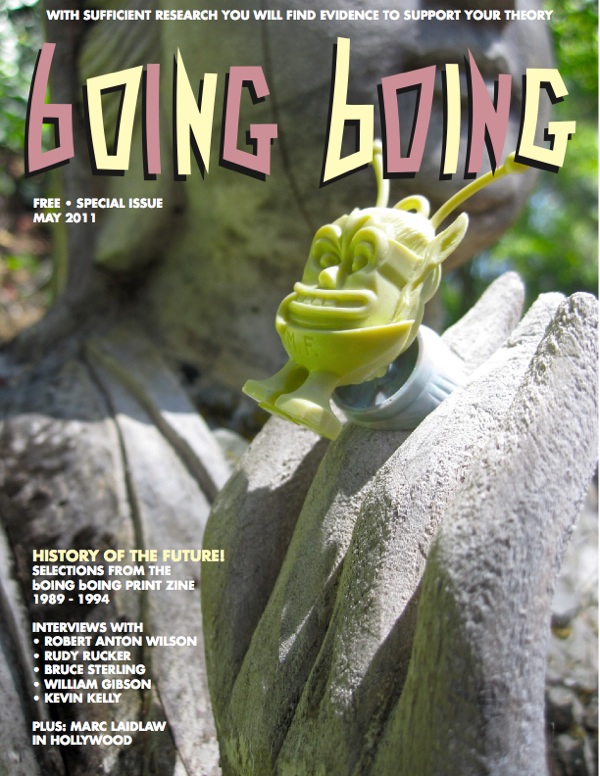 The anthology, called bOING bOING: History of the Future! is a collection of interviews with and articles by some of our favorite writers and thinkers - Robert Anton Wilson, Rudy Rucker, William Gibson, Kevin Kelly, Marc Laidlaw, and Bruce Sterling. In the coming weeks, we'll be running posts about the articles included in the bOING bOING: History of the Future anthology. The first piece in the new issue is an interview with author William Gibson, whose novel Neuromancer introduced me to the fantastic cyberpunk science fiction genre. bOING bOING's interview with William Gibson ran in bOING bOING #12 (cover at left) and was published in 1993 or 1994. In the interview, Gibson was asked if he thought the technology he'd envisioned in the 1980s would soon manifest itself in the real world. He said, "I don't think we're going to see anything too drastic happening culturally around computers until the user-interface evolves to the point where it's easy to use. I mean when you say 'hey, I do a lot of e-mail' or 'hey, I hang out on the Internet' -- the reason that has a kind of elite buzz to it, is that the learning curve is still too steep." In addition to this entertaining interview, bOING bOING #12 contained a two-page comic strip about the legal battle between Margaret and Walter Keane, who painted those famous big-eyed sad kids. The document is in Microsoft Word format but you can view it online at the SkyDrive whether you have Word on your computer or not. And if you'd like to download it for local perusal or printing and don't have a recent version of Microsoft Word or one of the many other applications that can open the document, you can use the free Word Viewer for Windows or Quick Look built into Mac OS X . The History of the Future! A free anthology of articles from the bOING bOING print 'zine 1989-1997 (SkyDrive) |
| You've been a bad, bad sysadmin Posted: 18 May 2011 03:51 PM PDT  "Handcrafted Fire-Colored Cat-5 Cable Flogger," Etsy user feralswirl, a mere $10. |
| Locke & Key: creepy and excellent graphic novel Posted: 18 May 2011 02:47 PM PDT  Locke & Key is a dark supernatural comic book series available in anthology format by writer Joe Hill and cartoonist Gabriel Rodriguez. I won't be spoiling it to say it's about a family (the Lockes) whose father (a high school counselor) is murdered by a couple of his deranged students who have been directed by an otherworldly creature to retrieve two powerful artifacts (as you might guess from the title, they're keys). Locke's grieving widow and three children move from Northern California to the murdered father's childhood home in New England to get away from the bad vibes. The only problem is, the home is a dark Victorian mansion, and it's in a town called Lovecraft. Locke & Key is a dark supernatural comic book series available in anthology format by writer Joe Hill and cartoonist Gabriel Rodriguez. I won't be spoiling it to say it's about a family (the Lockes) whose father (a high school counselor) is murdered by a couple of his deranged students who have been directed by an otherworldly creature to retrieve two powerful artifacts (as you might guess from the title, they're keys). Locke's grieving widow and three children move from Northern California to the murdered father's childhood home in New England to get away from the bad vibes. The only problem is, the home is a dark Victorian mansion, and it's in a town called Lovecraft. The gore and violence is over the top, and the mature subject matter prevented me from sharing the book with my 13-year-old daughter. Violence and darkness aside, Joe Hill's story is tight and well told, skillfully weaving flashbacks and present-day scenes, and inserting elements of foreshadowing to add just the right amount of complexity to the plot. Hill is the author of the acclaimed horror novel, Heart-Shaped Box (and his dad is Stephen King, which I just found out about 15 seconds ago). I'm not familiar with Gabriel Rodriguez, the Chilean artist who drew Locke & Key, but his work is terrific. I have seen too many comics lately where the characters physical features vary from panel to panel so much that they are unrecognizable. Rodriguez's characters are extremely well-designed and consistent throughout the book, making it easy to figure out who is who. That might not seem like a big deal, but to someone like me, who isn't that great at recognizing faces, it's a big help. His depictions of architecture is stunning. Most supposedly-scary novels and movies don't affect me, even though I enjoy them. But Locke & Key was both enjoyable and spooky. I highly recommend it. I also found out that Fox is shooting a pilot based on the series. Locke & Key |
| U.S. Secret Service pulls a herp derp on Twitter Posted: 18 May 2011 02:48 PM PDT  Just nine days after joining Twitter, the Secret Service had its first major public relations blunder. Earlier today, posted on the @SecretService account: "Had to monitor Fox for a story. Can't. Deal. With. The. Blathering." The tweet was deleted promptly, and the agency said an "internal follow-up" was in progress. "An employee with access to the Secret Service's Twitter account, who mistakenly believed they were on their personal account, posted an unapproved and inappropriate tweet," read a statement from the agency this afternoon. "We apologize for this mistake, and the user no longer has access to our official account. Policies and practices which would have prevented this were not followed and will be reinforced for all account users." Too bad: this was the first tweet from the account that read like it came from a human being. |
| Standing Desk Jockey: Kai Vermehr of eBoy Posted: 18 May 2011 01:52 PM PDT 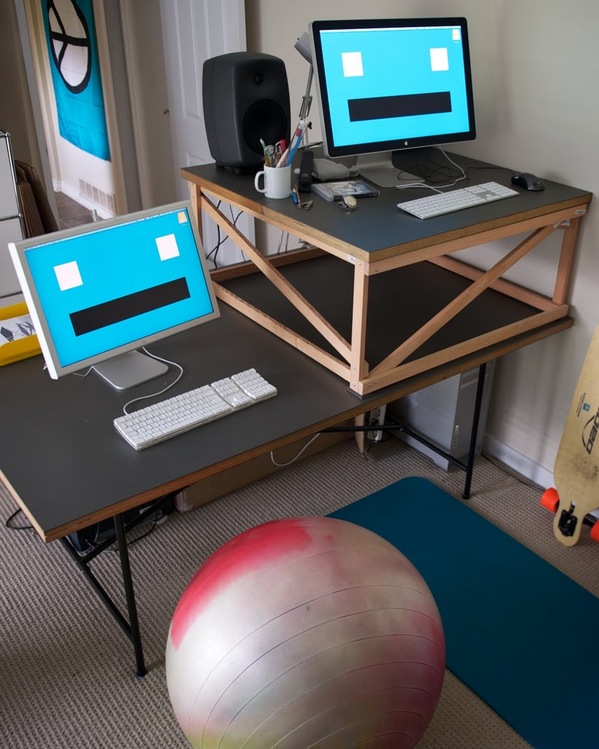 Artist Kai Vermehr of eBoy recently switched to a standing desk and he loves it. Artist Kai Vermehr of eBoy recently switched to a standing desk and he loves it. I finished the standup desk this weekend. The tabletop is a bit fancier than intended as I had two linoleum planks from a prior project. Also I placed my second monitor at the normal height so I could switch if I get tired. But I'm a bit stunned by the additional energy I'm experiencing since I stand. So I do not sit much anymore. Build your own table just like Kai's! He uploaded a model of the table to the SketchUp 3D warehouse. |
| Sunglasses that make you look like you've had your eyes blacked out Posted: 18 May 2011 01:31 AM PDT 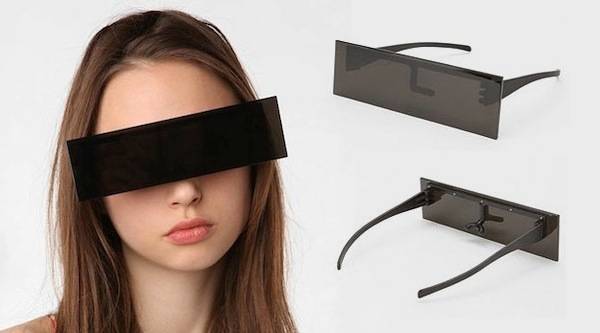 These novelty "Embarrassing Photo Protective Sunglasses" make you look like you've had your eyes blacked out by a censor bar: "Worried a paparazzo took a shot of you doing that thing you do that nobody knows about, because it would get you fired, arrested or worse?" They used to be sold by Urban Outfitters, but appear to have been discontinued. |
| Billions of planets, alone in space? Posted: 18 May 2011 01:15 PM PDT 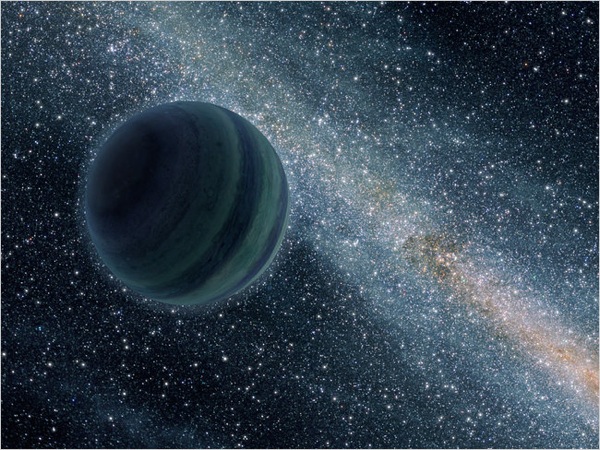 Hundreds of billions of planets the size of Jupiter are floating alone in space, or are so very far from their host stars that those stars aren't easily identifiable as associated with the planets. From the NY Times: "It's a bit of a surprise," said David Bennett, a Notre Dame astronomer, who was part of the team. Before this research, it was thought that only about 10 or 20 percent of stars harbored Jupiter-mass planets. Now it seems as if the planets outnumber the stars..."Billions of Lonely Planets, Adrift in Space" (Thanks, Jody Radzik!) |
| Posted: 18 May 2011 01:02 PM PDT 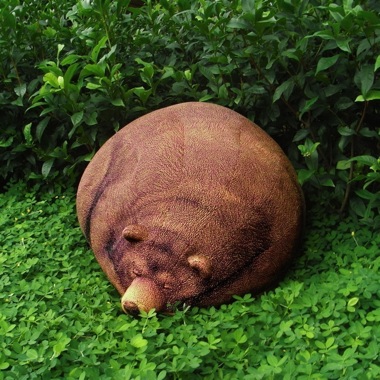 This is a bean bag disguised as a grizzly bear. It can be yours for $168 on Etsy. Also available from Chic Sin Design, topiary ball beanbag chairs, tree log bolster pillows, and rolled or folded banknote pillows. This is a bean bag disguised as a grizzly bear. It can be yours for $168 on Etsy. Also available from Chic Sin Design, topiary ball beanbag chairs, tree log bolster pillows, and rolled or folded banknote pillows.Big Sleeping Grizzly Bear Bean Bag (Thanks, Vann Hall!) |
| Super senses exist, we're just too distracted to notice them Posted: 18 May 2011 11:17 AM PDT Technically, we all have the capability for what could be described as "superhuman" hearing, sight, and smell. A healthy young adult can see a candle flame from 30 miles away. We can detect a smell when just 30 molecules of certain substances are present. So why don't we feel like our senses are super strong? According to neuroscientist Bradley Voytek, it's because we aren't paying enough attention. Basically, what we can sense under optimal conditions doesn't reflect what we do sense in the busy, distracting, real world. |
| Portal prank: covering up crosswalk button sign Posted: 18 May 2011 01:01 AM PDT 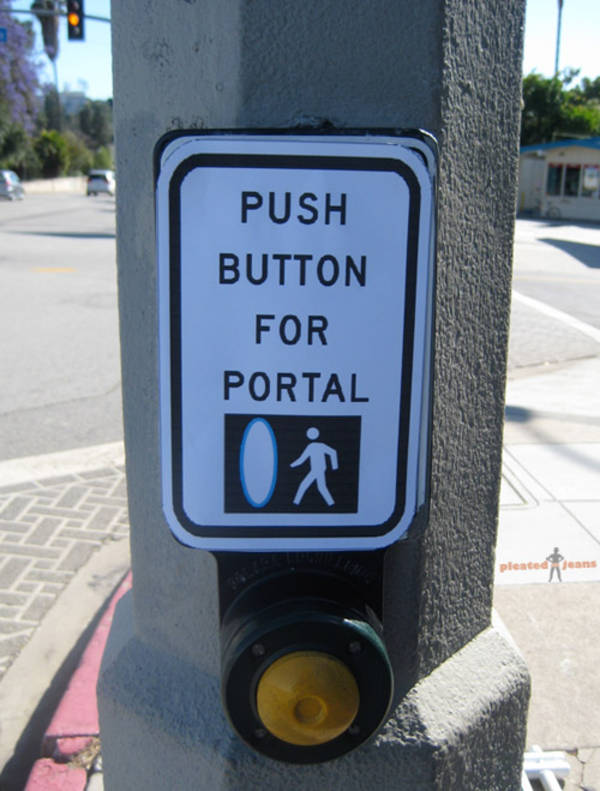 Someone's replaced crosswalk button with this funny reference to Portal, an addictive puzzle-game that uses a gun that generates "portals" that allow you to teleport through space. |
| Posted: 18 May 2011 11:15 AM PDT 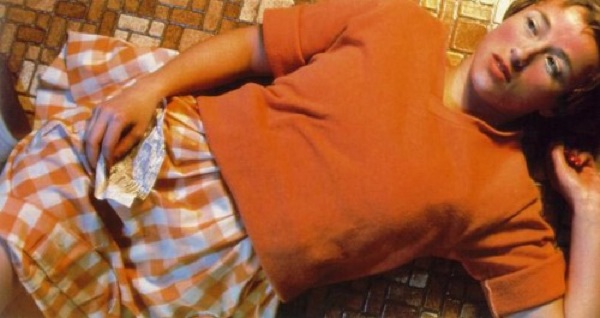 This is the most expensive photograph ever purchased. Art dealer Philippe Segalot purchased Cindy Sherman's "Untitled #96" (1981) for $3.89 million at a Christie's auction last week. I wonder how much Segalot will flip it for. "Cindy Sherman Print Sells For $3.9 Million At Auction, The Highest Ever For A Photograph" (Popular Photography, thanks Bob Pescovitz!) |
| An explanation for Roswell that's crazier than aliens Posted: 18 May 2011 11:05 AM PDT Annie Jacobsen, an editor at the Los Angeles Times Magazine, has written a book purporting to tell the real history of Area 51 and the Roswell Incident. Her book, which is based largely on interviews with people who lived and worked at Area 51, manages to simultaneously explain why the site would be so highly classified, while also trading in kind of mundane Cold War shenanigans—in other words, it's fairly believable. That is, except for the explanation one source gave her for Roswell, which is possibly the most insane story I have ever heard about that supposed alien crash landing. (And I watched the WB teen drama.) Scroll down to the section on "Interview Highlights" to read it. |
| Free download of horror film The Tunnel Posted: 18 May 2011 11:11 AM PDT [Video Link] The horror film, The Tunnel, is being offered for free, as a torrent. If you like it, you can kick in some money here. In 2007 the New South Wales government suddenly scrapped a plan to utilise the water in the disused underground train tunnels beneath Sydney. In 2008, chasing rumours of a government cover-up and urban legends surrounding the sudden backflip, investigative journalist Natasha Warner led a crew of four into the underground labyrinth. They went down into the tunnels looking for a story - until the story found them.I'm downloading it now. |
| HOWTO take pictures at a club/bar/venue Posted: 18 May 2011 12:51 AM PDT  Jamie Zawinski, who owns San Francisco's DNA lounge, has some practical advice for people trying to shoot photos in dark venues, bars and clubs. In addition to tips on composition and lenses, he's got a lot of good solid stuff on bar etiquette: Stop standing still.Nightclub photography: you're doing it wrong. (Image: JWZ: The Sounds) |
| Posted: 18 May 2011 10:48 AM PDT  You'd assume that identical twins would respond to being infected with the same virus in pretty much the same ways. So why, years after they were infected with HIV, could one twin be mostly healthy and the other very sick? I'm fascinated by the genetic differences that allow some people to basically be healthy carriers of HIV. But the answer behind this story wasn't what I was expecting. At the Virology Blog, Amanda Carpenter explains:
Image: Twins, a Creative Commons Attribution (2.0) image from jayneandd's photostream |
| Middleweight public intellectuals defend Dominique Strauss-Kahn Posted: 18 May 2011 11:41 AM PDT  Photo: REUTERS/Emmanuel Dunand Yesterday it was Bernard Henri-Lévy, the Cirque du Soleil of modern philosophy. Today, it is Ben Stein, professor and presidential speechwriter, roused to insinuate that IMF chief Dominique Strauss-Kahn's alleged victim must be lying. Henri-Lévy merely waved his literary arms passionately, but Stein suggests class warfare is behind the hotel maid's claims and the "embarrassing" treatment that Strass-Kahn received. Also, did you know that in France, even printing photos of Strauss-Kahn (or anyone else) in handcuffs is illegal? He needn't worry much, though, because the French media's obsequiousness to political and cultural elites is legendary: in 2009, after one satirist mocked Strauss-Kahn by suggesting buildings be fitted with alarms to warn women of his approach, he was fired. [Reuters] Photo: REUTERS/Emmanuel Dunand Yesterday it was Bernard Henri-Lévy, the Cirque du Soleil of modern philosophy. Today, it is Ben Stein, professor and presidential speechwriter, roused to insinuate that IMF chief Dominique Strauss-Kahn's alleged victim must be lying. Henri-Lévy merely waved his literary arms passionately, but Stein suggests class warfare is behind the hotel maid's claims and the "embarrassing" treatment that Strass-Kahn received. Also, did you know that in France, even printing photos of Strauss-Kahn (or anyone else) in handcuffs is illegal? He needn't worry much, though, because the French media's obsequiousness to political and cultural elites is legendary: in 2009, after one satirist mocked Strauss-Kahn by suggesting buildings be fitted with alarms to warn women of his approach, he was fired. [Reuters] |
| All 6500+ pages of Elfquest comics online Posted: 18 May 2011 10:27 AM PDT The Beat comics blog reports that the complete archive of Wendy and Richard Pini's Elfquest comic book series is available online. The scan quality is excellent. All 6500+ pages of Elfquest comics online |
| 'Taint hard to find a physical link to male fertility Posted: 18 May 2011 11:43 AM PDT A study of 117 men found a key difference between guys who had kids, and guys who were being treated for infertility. Anogenital distance is, as you might guess, the distance between where your balls stop and your anus begins. The average measurement for the fertile men was 44.6 millimeters. For the infertile men: 31.8 mm. Even more tellingly, sperm density, and the number of active sperm, increased by leaps and bounds for every extra millimeter of anogenital distance. Another recent study found very similar results. Cory posted about that earlier research a few weeks ago. |
| Update on "Spanish Revolution" protests: riot police surrounding protesters in Madrid Posted: 18 May 2011 10:43 AM PDT A quick followup on yesterday's post about widespread demonstrations in support of democracy and economic equality in Spain: according to various sources, including tweets from people at the protests, police are out in full force. There are concerns that things could turn violent. Follow #spanishrevolution on Twitter for a sense of what's unfolding. @teleoperador is broadcasting a live webstream here. This flyer is circulating widely, online and in the plaza, and explains some of what the protesters want. |
| David Dobbs on the importance of open-source science Posted: 18 May 2011 10:04 AM PDT Right now, most scientific research exists behind paywalls. And expensive paywalls at that. A license to read a single peer-reviewed journal article can set you back $50. Depending on the journal, that number might be a little lower, or a little higher, but access usually doesn't come cheap ... even if the research was funded with public money. When I write about a paper, I usually have to request a copy from the researcher before I can even know whether the paper in question is one I want to write about. And it's not just journalists that get locked out. Even scientists themselves can't always get access to the papers they need to read in order to do their jobs. New science is being stifled by the old business of scientific publishing, argues science journalist David Dobbs. Open-access journals are different. These publications—the most famous being the Public Library of Science, or PLoS—make all the papers they publish available to anyone online, rather than printing expensive paper copies for subscribers. In a great article at his Neuron Culture blog, Dobbs makes the case for open-access science:
|
| You are subscribed to email updates from Boing Boing To stop receiving these emails, you may unsubscribe now. | Email delivery powered by Google |
| Google Inc., 20 West Kinzie, Chicago IL USA 60610 | |

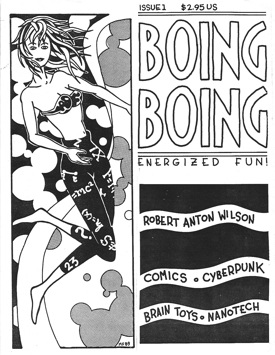 The first few issues of Boing Boing had print runs in the low hundreds, and the biggest was 17,500 copies. Today, the blog easily gets that many page views in an hour, so it's safe to say that the vast majority of Boing Boing readers have never read anything that appeared in those early zines. Today we're happy to announce that we've made available a free anthology of some of our favorite interviews from bOING bOING, the zine. You can
The first few issues of Boing Boing had print runs in the low hundreds, and the biggest was 17,500 copies. Today, the blog easily gets that many page views in an hour, so it's safe to say that the vast majority of Boing Boing readers have never read anything that appeared in those early zines. Today we're happy to announce that we've made available a free anthology of some of our favorite interviews from bOING bOING, the zine. You can 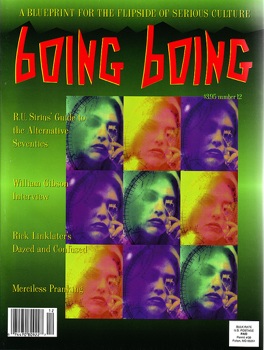 When I printed the first issue of Boing Boing in 1989, I located William Gibson's mailing address and sent him a copy. He wrote back with a complimentary letter, and I added him to the subscription list. I always appreciated receiving his occasional postcards, and reading interviews with him in other magazines where he mentioned bOING bOING as a zine he enjoyed.
When I printed the first issue of Boing Boing in 1989, I located William Gibson's mailing address and sent him a copy. He wrote back with a complimentary letter, and I added him to the subscription list. I always appreciated receiving his occasional postcards, and reading interviews with him in other magazines where he mentioned bOING bOING as a zine he enjoyed.  Speaking of fantasy, one of the pillars of the fantasy comics genres is now available in its entirety to read online. ELFQUEST, Wendy and Richard Pini's saga of homeless elves and their passions and battles, first published in 1978, was one of the foundational hits of the emerging indie comics scene, and after many publishers, movie options and assorted dramas, it's still a good story. Very few indie comics have spawned such a devoted cult or influenced so many spin-offs and imitators. Wendy Pini really hit the right notes at the right time with a style equal parts Kelly Freas, manga, and Walt Disney. It wasn't for everyone, but for those whose wheelhouse it hit, it was THE thing, with spin-off RPGs, novels and filk songs. ELFQUEST is also one of the first American comics to really nail the urgency and drama of manga storytelling.
Speaking of fantasy, one of the pillars of the fantasy comics genres is now available in its entirety to read online. ELFQUEST, Wendy and Richard Pini's saga of homeless elves and their passions and battles, first published in 1978, was one of the foundational hits of the emerging indie comics scene, and after many publishers, movie options and assorted dramas, it's still a good story. Very few indie comics have spawned such a devoted cult or influenced so many spin-offs and imitators. Wendy Pini really hit the right notes at the right time with a style equal parts Kelly Freas, manga, and Walt Disney. It wasn't for everyone, but for those whose wheelhouse it hit, it was THE thing, with spin-off RPGs, novels and filk songs. ELFQUEST is also one of the first American comics to really nail the urgency and drama of manga storytelling.
No comments:
Post a Comment